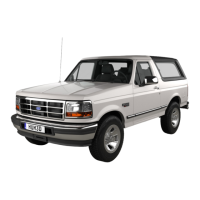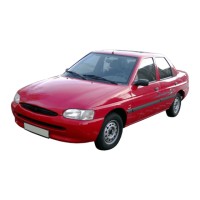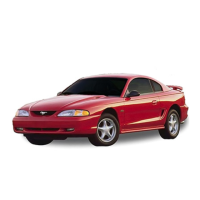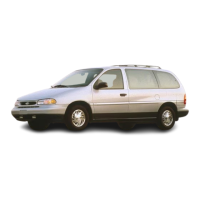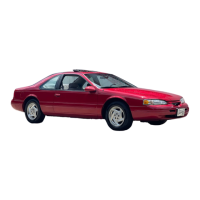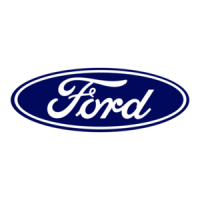
 Loading...
Loading...
Do you have a question about the Ford 1996 Aspire and is the answer not in the manual?
| Brand | Ford |
|---|---|
| Model | 1996 Aspire |
| Category | Automobile |
| Language | English |
Details Ford's commitment to excellence and dedication to customer satisfaction through product quality and service.
Outlines Ford's core principles including quality, customer focus, continuous improvement, employee involvement, partnerships, and integrity.
Provides guidance on how to use the owner's manual, including information on equipment, options, and specifications.
Explains the purpose of NOTES for additional information and WARNINGS for safety precautions to prevent damage or injury.
Offers advice on locating specific information within the manual using the Quick Index, Table of Contents, and Index features.
Describes the maintenance schedule booklet for keeping the vehicle in good condition and tracking services performed.
Details the vehicle's warranty coverage, including Basic Vehicle, Extended, and Emissions Warranties.
Explains the optional Ford Extended Service Plan for longer service protection beyond the basic warranty.
Explains what the VIN is and where to find it on the vehicle for identification and communication purposes.
Describes the location and content of the Safety Compliance Certification label, including manufacturer, date, and vehicle data.
Discusses regulations that may require additional equipment for specific vehicle uses and owner responsibility.
Provides instructions for the initial break-in period, including avoiding sudden stops and using recommended engine oil.
Details the proper use of safety belts for restraining occupants and outlines conditions for best restraint effectiveness.
Explains how combination lap and shoulder belts adjust to movement and lock during braking or impact.
Describes the dual locking modes of retractors: vehicle sensitive (emergency) and automatic locking modes.
Information on obtaining and using a safety belt extension assembly to increase belt length.
Guidance on periodically checking safety belt systems for proper function and damage, especially after a collision.
Explains the function of airbags as supplemental restraint systems and their interaction with safety belts.
Stresses the importance of proper seating position for airbag effectiveness and to prevent injury during inflation.
Covers legal requirements for child restraints and emphasizes using appropriate safety seats for children.
Provides recommendations for selecting and installing child safety seats, including the use of tether straps.
Details the process of installing tether straps for child safety seats in both front and rear seats.
Information on tether anchor hardware kits for child safety seats, including installation and positioning.
Guidance on proper use and adjustment of safety belts for children who have outgrown child safety seats.
Explains the different positions of the ignition lock cylinder and their functions.
Describes the shift-lock system that prevents shifting out of Park without brake pedal engagement.
Provides instructions for using the override mechanism to move the gearshift lever out of Park.
Details the procedure for safely removing the ignition key, ensuring the vehicle is properly secured.
Offers advice on starting fuel-injected engines, emphasizing avoiding accelerator use during startup.
Lists essential steps before starting the vehicle, including seatbelt use and checking accessories.
Step-by-step guide on how to start the engine, including proper key usage and accelerator avoidance.
Provides specific instructions for starting the engine in cold temperatures, including timing and flood prevention.
Offers guidance for starting a warm engine, focusing on starter protection and avoiding excessive cranking.
Troubleshooting steps for when the engine fails to start after initial attempts, involving accelerator usage.
Recommends using an engine block heater in cold regions to improve starting and warm-up.
Troubleshooting for engine starting issues following a collision, focusing on the fuel pump shut-off switch.
Advises on precautions to avoid the dangers of carbon monoxide in exhaust fumes.
Explains the function of the safety belt warning light and chime to remind occupants to fasten their belts.
Details the brake system warning light, its normal operation, and conditions indicating potential brake issues.
Describes the charging system light, indicating a potential issue with the battery charging system.
Explains the engine oil pressure warning light, signifying low oil pressure and potential engine damage.
Indicates when the headlamps are on high beam or when the lights are flashed.
Alerts to issues with the electronic engine control system, requiring prompt service.
Informs about the airbag system's readiness status, indicating potential issues if it fails to illuminate or stays on.
Indicates when the rear window defroster is activated and how to turn it off.
Warns of potential issues with the Anti-lock Brake System (ABS), requiring professional inspection.
Displays the amount of fuel remaining in the fuel tank.
Indicates the temperature of the engine coolant, warning of potential overheating.
Shows the vehicle's current speed in miles or kilometers per hour.
Records the total distance driven by the vehicle in miles or kilometers.
Records the distance of individual trips and can be reset to zero.
Details the operation of climate control systems, including heating and air conditioning functions.
Explains how to use levers to control air direction and temperature, and a knob for fan speed.
Allows selection between outside fresh air and recirculated interior air for climate control.
Adjusts the air temperature by moving the lever between blue (cool) and red (warm) areas.
Controls fan speed by turning a knob from OFF through speed 3 (high).
Step-by-step instructions for activating the heating system and adjusting temperature and fan speed.
Guide on using the climate control system to defrost windows, including fan speed and air direction settings.
Instructions for using climate controls to provide both heat and defrosting simultaneously.
How to use the climate system to bring fresh outside air into the vehicle for ventilation.
Advice on varying interior temperature, preventing fogging, and maintaining airflow.
Operation details for the air conditioning system, including maximum cooling settings.
Guidance on using the air conditioner with outside air for quieter, less efficient cooling.
How to quickly clear a fogged windshield using the air conditioning system.
Recommendations for improving fuel economy, such as using outside air and closing air doors.
Tips for operating the air conditioner after the vehicle has been parked in hot weather.
Explains the engine idle speed control system that compensates for AC compressor operation.
Instructions on operating the rear window defroster to clear frost, fog, or ice.
Information on interior lighting, including adjusting instrument panel brightness and courtesy lamps.
How to adjust the brightness of the instrument panel lighting using the dimmer control.
Details the three-position switch for the interior courtesy lamp (OFF, DOOR, ON).
Refers to the Audio Systems Chapter for detailed information about the vehicle's radio.
Instructions on extending and retracting the radio antenna for optimal reception and car wash protection.
Information on the built-in clock feature of electronic radios and how to operate it.
Guidance on cleaning the instrument panel lens safely to prevent scratches.
Explains how to use the turn signal lever to operate headlamps, turn signals, and flashers.
Instructions for turning on parking lamps and headlamps by twisting the knob on the turn signal lever.
Describes the chime that sounds when a door is opened while headlamps or parking lamps are on.
Advice on cleaning exterior lamps safely to avoid scratches or damage.
Explains the automatic illumination of DRLs in Canada and conditions under which they switch off.
How to operate high beams and flash headlamps using the turn signal lever.
Instructions for activating the hazard flasher to alert other drivers in hazardous situations.
How to use the lever to signal right or left turns, and for lane changes.
Operation of windshield wipers and washers, including standard and optional wiper speeds.
Details the one-touch function for a single wiper cycle.
How to operate the windshield washer to clean the windshield.
Troubleshooting advice if the windshield washer does not work, and precautions for freezing weather.
Instructions for operating the rear window wiper and washer system.
How to sound the horn and guidance on checking its proper operation.
Information on locking and unlocking doors using the key or inside lock buttons.
Details on how to lock and unlock front doors using the key and the inside lock button.
Explains the operation of exterior door locks and handles for opening doors.
Describes the function of inside door locks and handles for opening doors from within the vehicle.
Explains the childproof lock feature for rear doors, preventing them from being opened from the inside.
Information on operating side windows manually using the hand crank located on each door.
Guidance on raising or lowering side windows and addressing buffeting or wind shock.
General safety warnings related to seat adjustment and proper seating positions.
Instructions for moving front seats forward/backward and tilting the seatback.
Details on how to recline the seatback to a desired position and ensure it is locked.
How to gain access to the rear seat by tilting the seatback and adjusting the front seat.
Instructions for folding down rear seatbacks to create extra cargo space.
How to raise the rear seat cushion to provide additional cargo space after folding down seatbacks.
Guidance on cleaning vinyl and fabric seats, including spot removal and cleaner testing.
Information on rearview and side view mirrors, including adjustment and folding features.
Details on adjusting the rearview mirror for day/night positions and tilt.
Explanation of manual or remote adjustment of side view mirrors and folding for car washes.
How to use sun visors to block sunlight from the windshield and side window.
Location and usage notes for cupholders, advising against placing heavy objects in them.
Lists various storage compartments available in the vehicle, such as map pockets and glove compartment.
Instructions for opening and closing the hatchback lid, including key usage and securing.
Step-by-step guide for operating the hatchback, emphasizing proper closure before driving.
Information on the luggage compartment lamp and its On/Off positions.
Guide to operating the radio, including turning it on/off and adjusting volume levels.
Detailed steps for powering the radio on/off and adjusting the volume using the buttons.
How to switch between AM, FM1, and FM2 frequency bands using the AM/FM button.
Methods for tuning to stations: manual tuning, SEEK, and using memory preset buttons.
Explains using AMS for manual tuning, changing frequency, and fast-forward/rewind functions.
How to automatically select listenable stations up or down the frequency band using the SEEK button.
Details the SCAN function for automatically stopping at listenable stations for brief sampling.
Instructions for setting and using station memory preset buttons for AM and FM stations.
Guidance on adjusting bass, treble, speaker balance, and fader controls for audio output.
How to adjust bass levels using the AUDIO and VOLUME buttons.
How to adjust treble levels using the AUDIO and VOLUME buttons.
How to adjust sound distribution between left and right speakers using the AUDIO and VOLUME buttons.
How to adjust sound distribution between front and rear speakers using AUDIO and VOLUME buttons.
Instructions for using the cassette tape player, including inserting tapes and locating tracks.
Guidance on properly inserting a cassette tape into the player.
Notes on how tape tracks are indicated and how the mechanism reverses.
Instructions for stopping and ejecting the cassette tape from the player.
Details on activating and deactivating the Dolby B noise reduction feature.
Precautions for maintaining the cassette player and tapes for optimal performance.
Instructions on viewing the clock mode and setting the clock on electronic radios.
Factors affecting radio reception, such as distance, strength, and terrain.
Details on warranty coverage for the sound system and recommendations for service.
Explanation that driving procedures differ based on whether the vehicle has a manual or automatic transaxle.
Guide to operating the vehicle with an automatic transaxle, including putting it in gear.
How to engage gears in an automatic transaxle for fully automatic or manual control operation.
Instructions for using a console-mounted shift selector lever in automatic transaxle vehicles.
Guidance on how to back up the vehicle safely, emphasizing stopping before shifting into Reverse.
Explains the normal driving positions for the automatic transaxle, including D (Drive) and manual control.
Describes the normal driving position and automatic up/downshifting behavior of the transaxle.
Guidance on using First gear, including speed limitations and upshifting options.
Recommendations for using Second gear in various driving conditions like heavy traffic or hills.
Procedure for parking the vehicle, ensuring secure latching in P (Park) to lock the transaxle.
Instructions for operating a vehicle with a manual transaxle, including clutch usage.
Guidance on clutch operation after starting the engine and moving the vehicle.
Explanation of the gearshift pattern and the importance of fully engaging the clutch when shifting.
Recommendations on upshifting speeds for optimal performance and fuel economy.
Benefits of downshifting for slowing down, climbing hills, and preventing stalling.
Procedure for parking the vehicle, including setting the parking brake and turning off the ignition.
Information on power steering operation, checking the system, and manual steering effort.
Explanation of the brake system, including applying brakes and stopping distance.
How to apply brakes, including the 'squeeze' technique and considerations for loss of power assist.
Details the function of the ABS system in preventing brake lock-up and its operation.
Guidance on using the parking brake for stopping and parking, including its limitations.
Tips for safe driving, including operating limits and handling maneuvers.
Advice on adapting to a new vehicle's handling, operating within limits, and managing maneuvers.
Precautions for driving on slippery roads, including speed, braking, and gear selection.
Guidance on driving cautiously on wet or snowy roads, focusing on steering, speed, and braking.
Advice for driving through flooded areas, emphasizing caution with traction and brake drying.
Information on vehicle weight limits (GVWR, GAWR) and tire load ratings.
States that the Aspire is not designed for towing trailers.
Recommendations for towing the vehicle behind another vehicle, like an RV, using a dolly or trailer.
Instructions and safety precautions for jump-starting a vehicle with a discharged battery.
Steps for preparing your vehicle and the booster vehicle for jump-starting, including safety checks.
Detailed procedure for connecting jumper cables correctly to both batteries and vehicles.
Steps for starting the engine after connecting jumper cables, including charging and troubleshooting.
Instructions for safely removing jumper cables in the reverse order of connection.
Guidance on changing a flat tire, including safely moving the vehicle and preparing for the change.
Information about the temporary spare tire, its limitations, and precautions for use.
Location of the spare tire and tools stored in the rear luggage compartment.
Steps to prepare the vehicle for changing a tire, including securing the vehicle and blocking wheels.
Detailed instructions for removing the wheel, replacing the tire, and tightening lug bolts.
Information on contacting professional towing services and suggested towing options.
Details the 24-hour roadside assistance hotline, its coverage, and how to purchase extended coverage.
Guidance on using roadside assistance, including finding the identification card and contact numbers.
Information on authorized Ford dealerships for vehicle service and how to address service concerns.
Ford's recommendation for servicing at selling or any authorized dealer and escalating unresolved concerns.
Details the voluntary dispute settlement program for qualifying Ford vehicles and its review process.
Outlines the types of unresolved warranty complaints reviewed by the Board.
Explains the structure of the Board, membership, and the process for making decisions.
Provides the address for requesting a brochure and application form for the Dispute Settlement Board.
Instructions for reporting vehicle safety defects to NHTSA and Ford Motor Company.
Contact information for Ford Motor Company of Canada for customer assistance and concerns.
Details the CAMVAP program for resolving factory-related service concerns through mediation/arbitration.
Advice for exporting vehicles, obtaining unleaded fuel, and servicing vehicles abroad.
Lists Ford products available for cleaning and protecting the vehicle's finishes.
Categorizes accessories related to safety, comfort, and convenience features.
Lists accessories focused on protecting the vehicle's appearance and body.
Ford's goals for servicing: designing low-maintenance parts and making service easy.
General safety precautions to follow when inspecting or servicing the vehicle.
Steps to take for safe servicing when the engine is turned off, including securing the vehicle.
Precautions for servicing the vehicle while the engine is running, emphasizing safety.
Instructions for opening the vehicle's hood, including releasing the latch and securing the prop rod.
Identifies the vehicle's engine type as a 1.3L, fuel-injected, four-cylinder engine.
Guidance on cleaning the engine for efficiency and preventing damage from water or high pressure.
Instructions for opening the fuel door and filling the fuel tank properly.
Recommendations for using unleaded fuel and avoiding the use of leaded or incorrect fuel types.
Specifies the recommended octane rating (87) for unleaded fuel and advice on fuel quality.
Discusses fuel quality issues like low volatility and persistent conditions requiring technician attention.
Information on oxygenated fuels required in certain areas for air quality improvement.
Crucial safety warnings regarding automotive fuels, including fire hazards and ingestion risks.
Advises against running out of fuel due to potential adverse effects on powertrain components.
Explanation of how to calculate fuel economy (MPG or L/100K) and factors affecting it.
Tips for improving fuel economy by understanding and minimizing variables that reduce efficiency.
Recommends using Motorcraft or equivalent oil meeting API certification and preferred viscosity (SAE 5W-30).
Procedure for checking engine oil level using the dipstick and adding oil as necessary.
Guidance on engine oil and oil filter change intervals based on mileage or time.
Information on checking engine coolant level, its importance, and precautions.
How to check the engine coolant level by examining the reservoir and radiator.
Instructions for adding engine coolant to the reservoir, emphasizing proper mixture and warnings.
Guidance on inspecting engine and heater system hoses for deterioration, leaks, or loose clamps.
Information on windshield washer fluid levels, wiper blade condition, and replacement.
How to check windshield washer fluid level and precautions for freezing weather.
Details on the rear window wiper/washer system operation and reservoir location.
Advice on checking wiper blade effectiveness, cleaning them, and replacing the assembly.
Step-by-step guide for replacing wiper blades, including removal and attachment.
Guidelines for tire inspection, maintenance, and precautions for proper inflation and load limits.
Instructions for inspecting tire treads and sidewalls for damage and making necessary repairs.
Explanation of why and how to rotate tires for even wear and longer tire life.
Recommendations for replacing tires, including using all-weather tires and identifying wear bands.
Importance of proper servicing procedures for wheels and tires, including matching and remounting.
Explanation of Tire Quality Grades (Treadwear, Traction, Temperature) molded into tire sidewalls.
How to clean wheels using detergent, avoiding abrasive cleaners and chemicals.
Maintenance tips for the battery, including keeping it clean, dry, and ensuring secure cable connections.
Information on battery replacement options, including Motorcraft Low-Maintenance batteries.
Recommendation to return used lead-acid batteries to an authorized recycling facility for disposal.
Information on automatic transaxle fluid, its normal non-consumption, and when to check the level.
Procedure for checking automatic transaxle fluid level, including engaging gears and reading the dipstick.
Guidance on manual transaxle fluid, suggesting periodic checks by a Ford Dealer.
Procedure for checking manual transaxle oil level by removing and cleaning the speedometer gear.
Explains brake fluid levels, wear on pads, and how to check the fluid in the master cylinder.
Guidance on checking power steering fluid levels twice a year and adding fluid as needed.
Explains the role of fuses in protecting the electrical system and troubleshooting blown fuses.
Instructions for locating and replacing fuses in the main fuse block under the hood.
Detailed steps for finding, removing, inspecting, and replacing fuses using a fuse puller.
Explains how circuit breakers protect systems from high amperage and how to reset them.
Guidance on checking exterior and interior lights and replacing bulbs.
Instructions for removing and installing headlamp bulbs, with safety precautions.
Step-by-step instructions for replacing the high-mount brakelamp bulb.
A table listing bulb specifications (wattage, trade number) for front, rear, and interior lighting.
Information on the catalytic converter and other emission control parts to ensure proper function.
Explains the OBD II system readiness for testing and the driving required to achieve it.
Detailed steps for the OBD II drive cycle required for system readiness testing.
Approximate refill capacities for vehicle fluids and lists of common Motorcraft parts.
Lists recommended Motorcraft parts with their corresponding part numbers.
Information on lubricants and fluids for the transaxle and steering systems, meeting Ford specifications.
Maintenance tips for storing the vehicle for extended periods (60 days or more).
Recommendations for storing vehicles in a dry, ventilated place and protecting them from sunlight.
Tips for body maintenance during storage, including washing, touching up metal, and lubricating parts.
Maintenance recommendations for the engine during storage, including starting and shifting gears.
Advice on filling the fuel tank and using fuel stabilizers for extended storage.
Recommendation to protect the cooling system against freezing temperatures during storage.
Tips for battery maintenance during storage, including checking and recharging as necessary.
Ensuring brakes and parking brake are fully released when storing the vehicle.
Maintaining recommended tire air pressure during vehicle storage.
Lubricating linkages and moving vehicle periodically to prevent rust and corrosion during storage.

